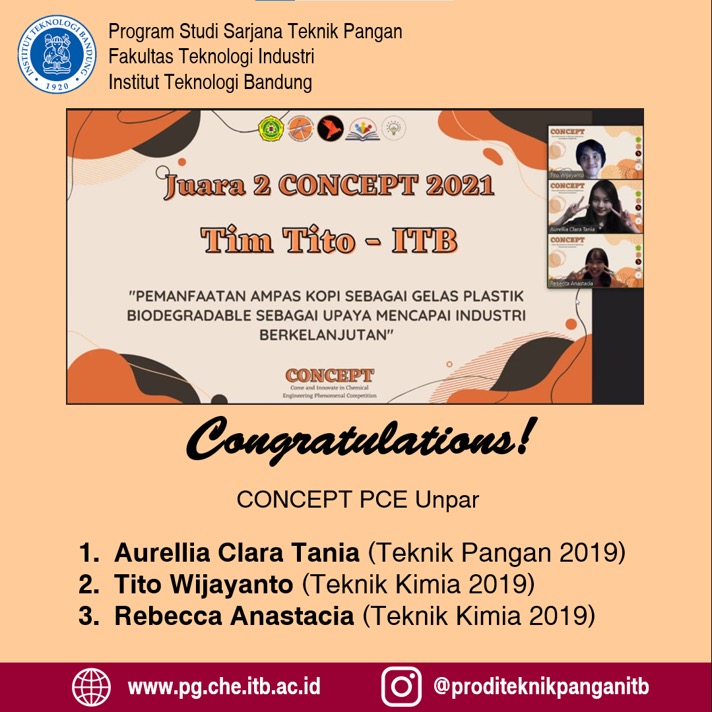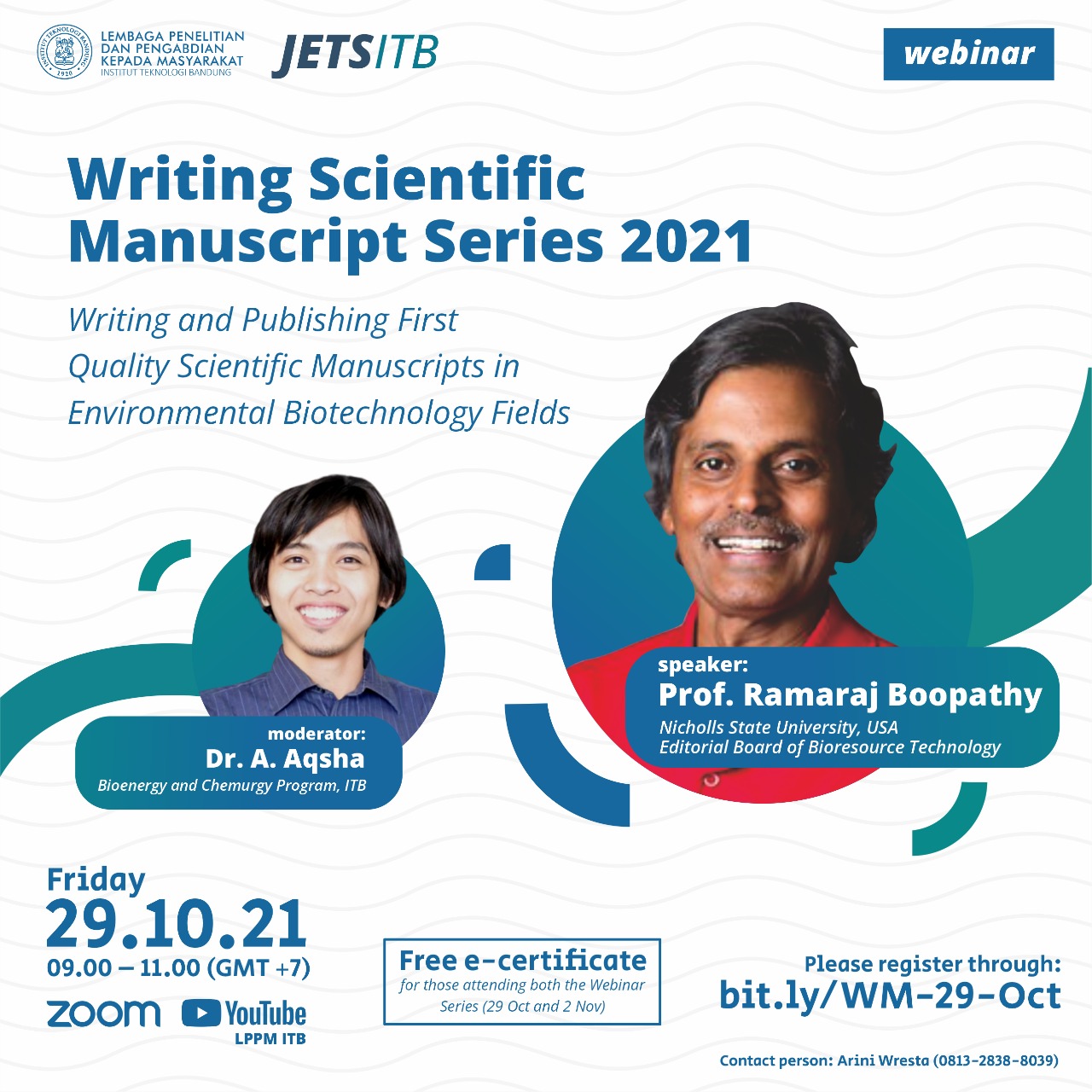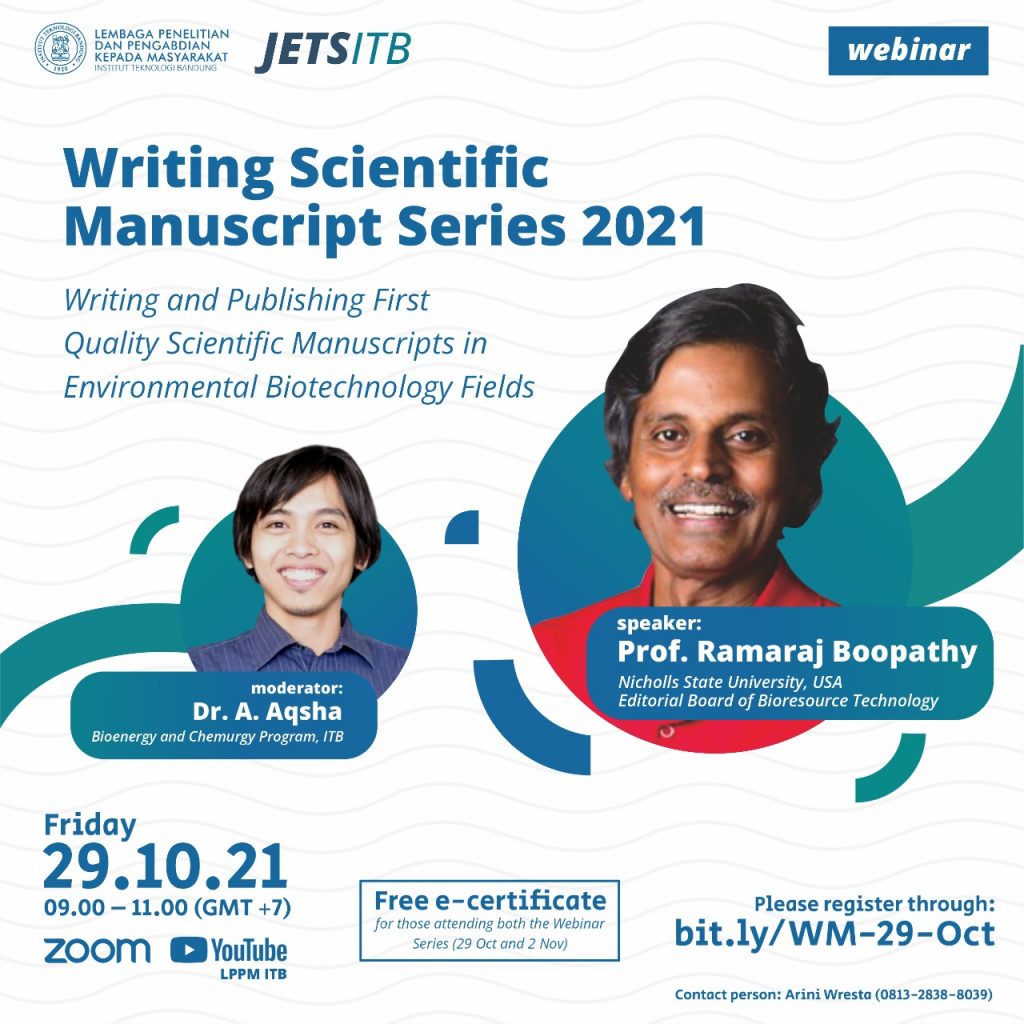[:id]
BANDUNG, itb.ac.id – Himpunan Mahasiswa Teknik Pangan Institut Teknologi Bandung (HMPG ITB) menyelenggarakan webinar mengenai teknik pangan pada Sabtu (5/2/2022). Sebagai salah satu rangkaian acara dari Food Engineering Festival (FEF ITB), kegiatan ini mengangkat judul “Foreseeing The Future of Food Engineering” dengan narasumber Dr. Ir. Dianika Lestari, S.T., M.T.
Dosen Teknik Pangan ITB itu mengawali paparan mengenai peran para insinyur pangan atau food engineer, yaitu dalam merancang dan mengembangkan teknologi serta sistem untuk proses produksi, distribusi, penyimpanan hasil pertanian serta bahan ingridien pangan dalam skala komersial. “Insinyur pangan juga berperan dalam menemukan solusi untuk mengatasi permasalahan dalam pengolahan pangan pada skala industri,” jelas Dr. Dianika.
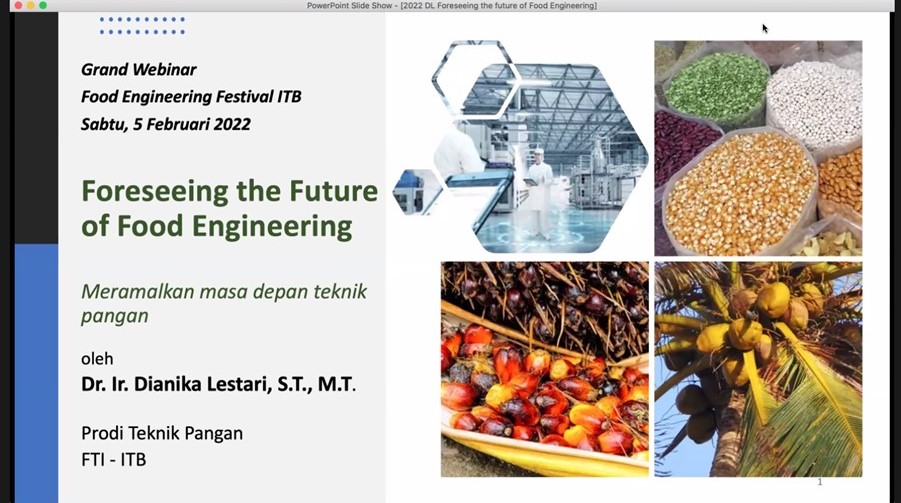
Tentunya untuk melakukan berbagai tugas tersebut, para insinyur pangan tidak sendirian. Terdapat berbagai aspek yang harus dipahami oleh para insinyur pangan. Mulai dari komoditas pangan di mana para insinyur pangan akan bekerja sama dengan para insinyur pertanian dan insinyur teknik pasca panen.
Lalu para insinyur pangan juga harus paham mengenai aditif pangan serta food ingredients untuk menghasilkan produk pangan yang aman dan baik, lalu dapat didistribusikan kepada masyarakat umum di pasaran.
Saat ini, tentunya masih ada beberapa permasalahan dalam sektor pangan di Indonesia. Pertama, pemanfaatan bahan baku pangan khas Indonesia untuk bahan komponen penyusun atau ingridien pangan masih terbatas. Selain itu, ahli teknik proses kimia Indonesia masih terbatas dalam melakukan perancangan teknologi proses produksi pangan untuk mengolah bahan baku pangan lokal khas Indonesia secara berkelanjutan.
Maka dari itu, para insinyur pangan dari program studi Teknik Pangan memiliki berbagai tugas dan peran untuk masa depan pangan Indonesia. Pertama, insinyur pangan Indonesia harus mampu menciptakan teknologi baru untuk memanfaatkan potensi sumber daya pangan Indonesia. Hal ini tentunya menjadi hal yang harus segera direalisasikan karena Indonesia memiliki sangat banyak potensi sumber daya pangan yang kaya akan kandungan gizi yang dapat dikomersialisasi dan juga dikembangkan untuk membantu perekonomian, mensejahterakan masyarakat, serta memajukan negara Indonesia.
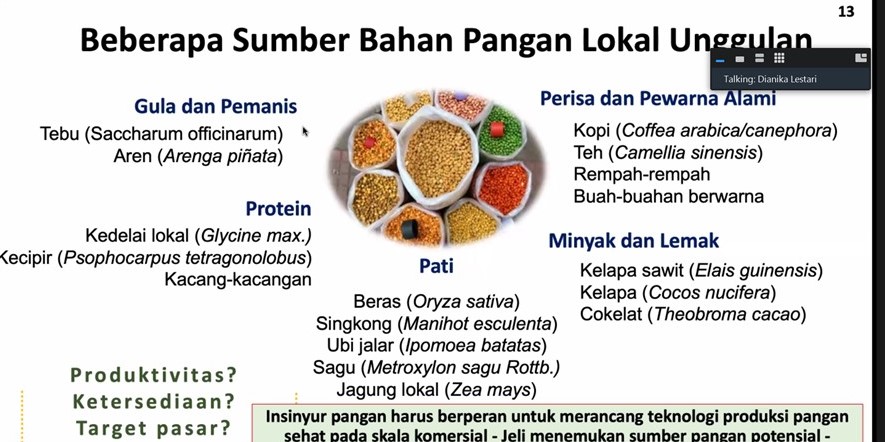
Kedua, kualitas serta mutu pangan yang dihasilkan harus sangat diperhatikan dan juga dijaga dengan sangat baik karena bahan pangan adalah bahan yang sensitif dan langsung bersentuhan dengan manusia sepenuhnya. “Hasil pangan harus terjaga kontinuitasnya, kualitasnya, serta kapasitasnya agar bisa diterima di kalangan Industri,” tegas Dianika.
Pangan yang sehat dan lezat harus menjadi tujuan perakitan teknologi pengolahan pangan masa depan. Produksi pangan sehat pada skala industri komersial akan menjadikannya lebih terjangkau untuk masyarakat luas.
Di sisi lain, para insinyur dari Teknik Pangan serta ITB pada umumnya, telah turut berkontribusi pula untuk menghasilkan berbagai teknologi pengolahan pangan masa depan untuk Indonesia. Hasil yang diciptakan adalah Closed Circulated Batch Reactor dan Closed Circulated Semi-Continuous Reactor. Kedua reaktor ini memiliki berbagai kelebihan. Mulai dari konsumsi air yang lebih efisien, kontrol kehigienisan yang lebih baik, serta muatan bahan untuk diproses yang lebih besar.
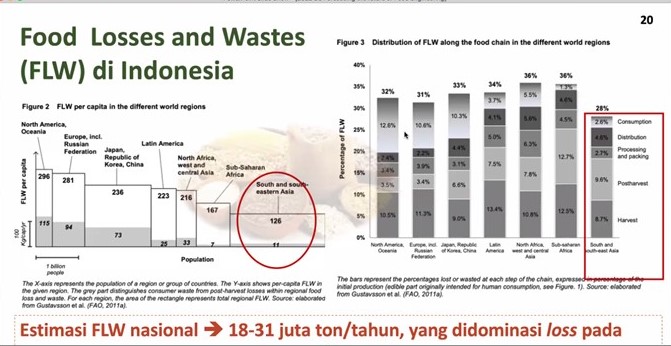
Permasalahan kedua yang juga harus dapat diatasi oleh para insinyur pangan adalah food waste atau limbah pangan yang kini menjadi masalah besar di seluruh dunia. Dalam skala nasional, estimasi total food loss atau food waste Indonesia mencapai 18 hingga 31 juta ton per tahun. Tentunya, hal ini merupakan kondisi yang mendesak untuk diperbaiki. Solusi yang kini sedang dikembangkan oleh para insinyur pangan adalah teknologi pengolahan buah kering dan pengolahan lanjut limbah pangan menjadi bahan yang bisa dimanfaatkan untuk hal lain.
“Bukan hanya itu, insinyur pangan juga harus mampu memperbaiki teknologi yang sudah ada saat ini menjadi teknologi yang lebih efisien dan lebih hemat sumber daya,” terang Dianika.
Selain itu, lanjut Dianika, para insinyur pangan juga harus beradaptasi dan juga bisa mengikuti perkembangan zaman terutama pada Industry 4.0 yang marak dengan otomasi industri, terutama pada sektor food processing, food packaging, dan food servicing yang kini banyak dijalankan oleh mesin dan teknologi.
Reporter : Yoel Enrico Meiliano (Teknik Pangan, 2020)
[:en]
BANDUNG, itb.ac.id – Himpunan Mahasiswa Teknik Pangan Institut Teknologi Bandung (HMPG ITB) held a webinar on food engineering on Saturday (5/2/2022). As one of a series of events from the Food Engineering Festival (FEF ITB), this activity has the title of “Foreseeing The Future of Food Engineering” and was brought by Dr. Ir. Dianika Lestari, S.T., M.T.
This Food Engineering ITB lecturer started her presentation about the role of food engineers, namely in designing and developing technology and systems for the production, distribution, storage of agricultural products and food ingredients on a commercial scale. “Food engineers also play a role in finding solutions to problems in food processing on an industrial scale,” explained Dr. Dianika.

Of course, to perform these various tasks, food engineers are not alone. There are various aspects that food engineers must understand. Starting from food commodities where food engineers will work closely with agricultural engineers and post-harvest engineering engineers.
Then food engineers must also understand food additives and food ingredients to produce safe and good food products, which can then be distributed to the consumers in the market.
Currently, of course, there are still some problems in the food sector in Indonesia. First, the use of Indonesian food raw materials for food components or ingredients is still limited. In addition, Indonesian process engineers are still limited in designing food production process technology to process local Indonesian food raw materials in a sustainable manner.
Therefore, food engineers from the Food Engineering study program have various tasks and roles for the future of Indonesian food. First, Indonesian food engineers must be able to create new technologies to exploit the potential of Indonesia’s food resources. This is certainly something that must be realized immediately because Indonesia has a lot of potential food resources that are rich in nutritional content that can be commercialized and also developed to help the economy, prosper the community, and advance the Indonesian state.

Second, the quality of the food produced must be very carefully considered and also maintained very well because food ingredients are sensitive materials and are in direct contact with humans completely. “Food products must be maintained for their continuity, quality, and capacity so that they can be accepted by the industry,” said Dianika.
Healthy and delicious food should be the goal of assembling future food processing technology. The production of healthy food on a commercial industrial scale will make it more affordable for the wider community.
On the other hand, engineers from Food Engineering and ITB in general have also contributed to producing various future food processing technologies for Indonesia. The results created are Closed Circulated Batch Reactor and Closed Circulated Semi-Continuous Reactor. Both of these reactors have various advantages. Starting from more efficient water consumption, better hygiene control, and a larger load of materials to be processed.

The second problem that food engineers must also solve is food waste, which is now a big problem all over the world. On a national scale, the estimated total food loss or food waste in Indonesia is 18 to 31 million tons per year. Of course, this is an urgent condition for improvement. The solution currently being developed by food engineers is technology for processing dried fruit and further processing food waste into materials that can be used for other things.
“Not only that, food engineers must also be able to improve the existing technology to become more efficient and resource-efficient technology,” explained Dianika.
In addition, Dianika continued, food engineers must also adapt and be able to keep up with the times, especially in Industry 4.0 which is rife with industrial automation, especially in the food processing, food packaging, and food servicing sectors, which are now mostly run by machines and technology.
Reporter : Yoel Enrico Meiliano (Food Engineering, 2020)
[:]


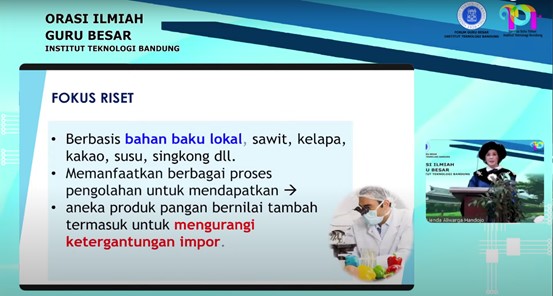

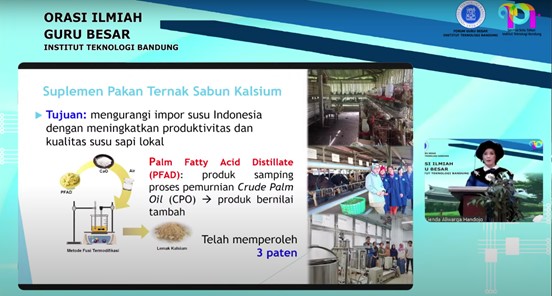
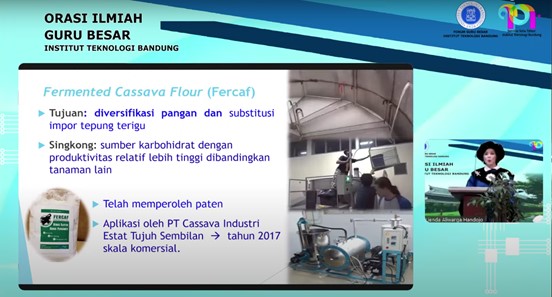
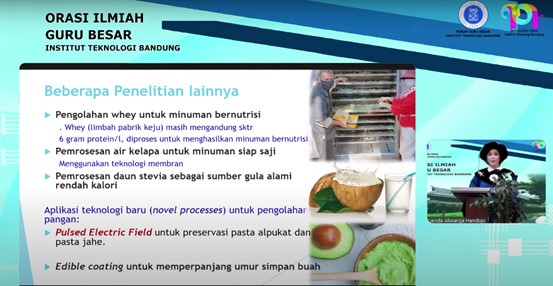
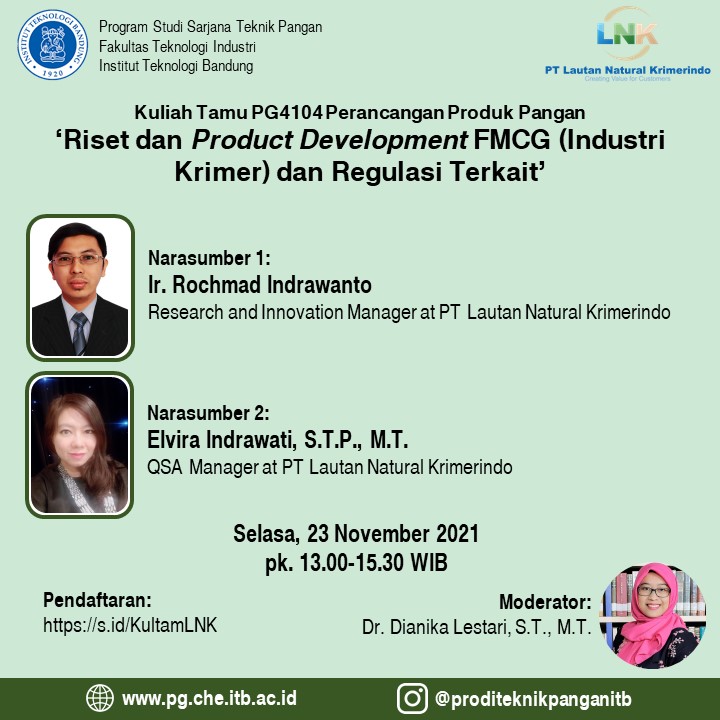


 [:en]
[:en]